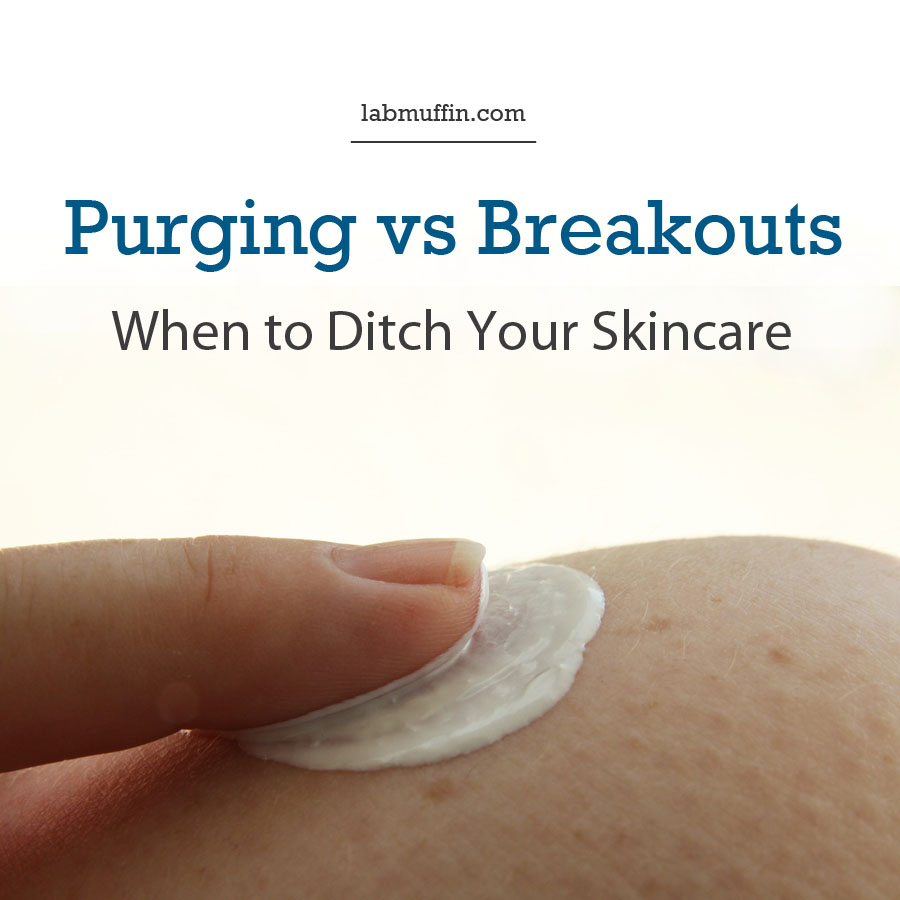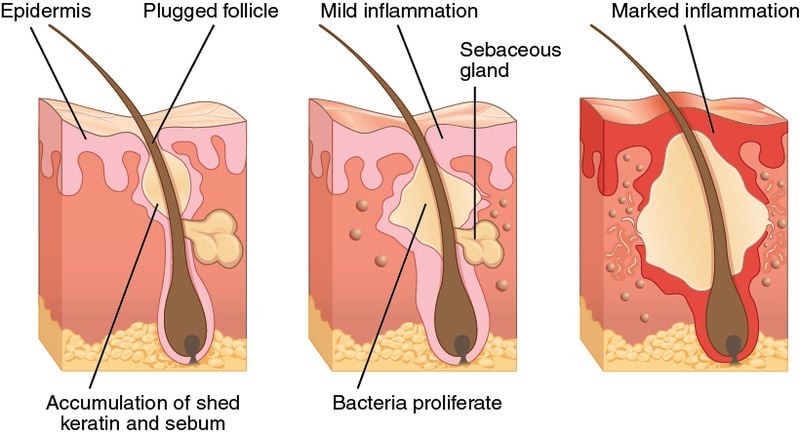When I Stopped Using Skin Products I Broke Out Again
Affiliate Disclosure: I receive a small commission for purchases made via affiliate links.

Have you e'er tried a new skincare production, but to discover that information technology makes your skin flare up with pimples? This could be purging, or it could exist reacting with a regular breakout.
Purgingis when your skin is adjusting to the new production, and persevering with the product will eventually make your skin improve – in fact, the sudden crop of pimples ways that it'south working as intended.
A regular breakoutis when your skin is reacting because it'southward sensitive to something in the product. It could be clogging your pores, or causing an allergy, or just plain old irritation. Continuing with the product will just make the state of affairs worse.
If your peel is purging, you lot need to go along going.
If your skin is reacting with a breakout, y'all need to stop using the product.
How practise y'all tell the difference? Hither'south the lowdown:
What causes purging?
To understand the difference between purging and obviously old breakouts, we demand to understand how they happen.
How a pimple forms
Firstly, we need to await at how a pimple forms. A pore becomes clogged – commonly by expressionless skin cells that don't detach and get to the surface properly – and forms what's chosen a microcomedone.
Microcomedones aren't visible at the surface of the skin. Sometimes they'll develop into a whitehead, blackhead, pimple or full-blown cyst; sometimes they'll go away on their own without you noticing. It can take up to 8 weeks for a microcomedone to surface.

Anatomy & Physiology, Connexions Website, OpenStax College
How purging happens
Here'southward how purging can actually piece of work – if a product speeds up skin turnover (the rate at which skin cells are shed and replaced), then the entire cycle will exist accelerated and microcomedones will turn into whiteheads/blackheads/pimples/cysts more quickly, and so y'all'll suddenly see a rush of blemishes rearing their ugly heads.
If the product is irritating (which most peel turnover-accelerating products are), some microcomedones that weren't going to show up might join the party too, since inflammation is i of the factors causing acne. Even so, these microcomedones were in the skin before yous started the new production, not new blockages caused by the product.
Now, think how the microcomedone started as dead skin cells that didn't disassemble and become to the surface properly? Products that increase pare turnover target this exact process to treat acne!
So as the product starts to work, less microcomedones should course, and after the initial angry-volcano stage your skin should become clearer than when yous started the product.
The difference with a reactive breakout
On the other hand, a reaction volition occur when the product is either causing new clogged pores, or increasing irritation without an comeback in how your skin is performance considering you're sensitive to it. New clogged pores means more blemishes overall, while irritation means inflammation, which ways a larger proportion of your microcomedones are flaring upwardly.
There'southward a small take chances that your skin will go used to the production over time, but about of the time you'll just cause farther damage and it's time to find a better product.
A lot of "all-natural" companies like to claim that their products are causing purging because your skin is detoxifying from all the synthetic chemicals you've been using previously – this is a big fat lie. Why would your pare suddenly get angry about having less synthetic chemicals on it? (Fifty-fifty if synthetic chemicals were bad – which they're not!)
Unless there's something increasing skin turnover in the natural skincare product (e.g. fruit acids, which contain AHAs), the more likely caption is that there'southward an irritating ingredient giving your skin grief.
Related Mail service: Video: Are Natural Beauty Products Better?
And so is it purging or a obviously quondam breakout?
There are a few things to consider to work out if it's purging or a reactive breakout, and therefore whether you should dump your product or persevere. A lot of the time it can be difficult to tell which it is, but hopefully these guidelines can assistance yous narrow it down.
What sort of production is it?
Products containing active ingredients that increment peel turnover can cause purging. Purging is a well-documented response to tretinoin, for example, although you won't discover the term "purging" used in the scientific journals (they utilize descriptions like "exacerbation of inflammatory lesions at the start of treatment" or "initial flare up of acne lesions (acne flaring)").
Active ingredients and treatments that increase skin turnover include:
- hydroxy acids (glycolic, lactic, malic, mandelic, salicylic, lactobionic acids; gluconolactone; "fruit acids")
- retinoids (retinol, tretinoin, adapalene, tazarotene, isotretinoin, retinyl palmitate)
- benzoyl peroxide
- chemic peels, lasers, microdermabrasion
- other exfoliants (scrubs, brushes, enzyme exfoliants)
About other products, like moisturisers and cleansers without these actives, won't exist able to crusade purging and you should switch to a different product.
Related: The Essential Guide to Exfoliation
Where are the breakouts occurring?
If it's purging, it should but brand pre-existing microcomedones come to the surface faster, so if yous're breaking out in places where you don't commonly experience breakouts, it's likely that the production is wrong for you. However, if it's an irritating product, it could be making the type of acne you're experiencing worse.
For example, an area where yous used to have clogged bumps and whiteheads could start developing full-blown pimples thanks to the extra inflammation.
Related Post: How to Use Instagram as a Skin Diary
How long is the purge?
Purging should only last for almost a calendar month, since that'due south the length of fourth dimension information technology take for your skin to completely renew itself. If your pare isn't getting meliorate after around 6-8 weeks with the new product, ditch it.
How can I reduce the severity of a purge?
If you're nearly to start a new product with an ingredient that tin crusade purging and you want to limit the severity of a purge, there's some evidence that introducing the new production slowly tin can aid. This means starting at a lower concentration, starting at a smaller amount, using it less oft, or washing it off later on a few minutes before gradually increasing to the recommended usage.
Helping your pare function at its all-time will besides reduce irritation and speed recovery: ensuring that your skin stays hydrated with the use of humectant moisturisers and moisturisers in general, using a gentle cleansing routine, using anti-irritant or antiinflammatory products and protecting your skin from the sun.
Related Post: My Emergency Routine for Treating an Irritant Breakout
feredaylationston.blogspot.com
Source: https://labmuffin.com/purging-vs-breakouts-ditch-skincare/